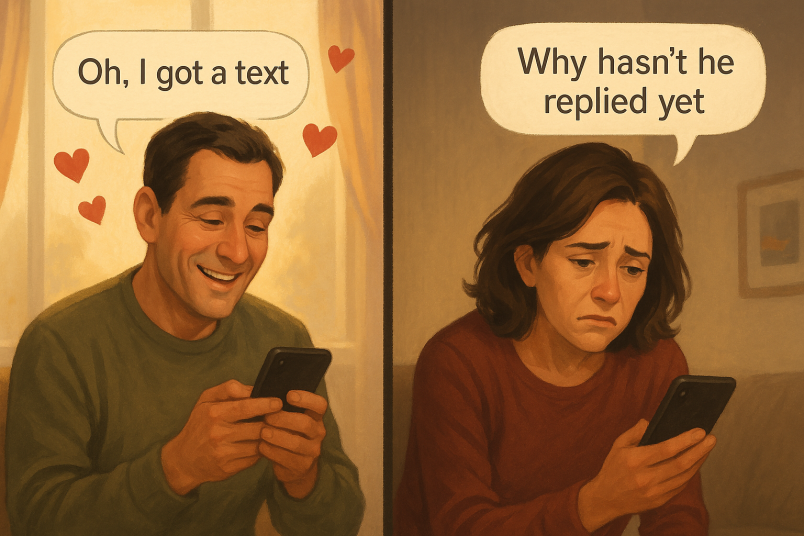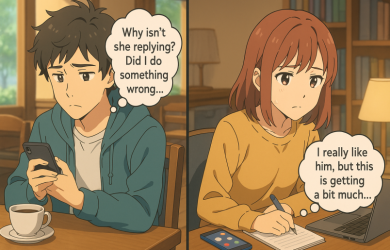What Are the Different Texting Types in Relationships—and How Do They Affect

Unlock Daily 30-Sec Tips for a Happier Relationship
👉 Subscribe FREEKey Takeaways
Marriage.com AI Quick Summary
It’s funny how a few little bubbles on a screen can carry so much weight, isn’t it? One “Hey” can make your whole day… while a left-on-read can sting more than it should.
We all have our ways of texting—the quick responder, the late-nighter, the emoji overloader—and sometimes, those differences say more than words themselves. You might find comfort in a steady stream of “good mornings,” or maybe you prefer space between replies.
These texting types don’t just shape conversations; they shape connection, too. And in love, the way we text often echoes the way we feel—whether we mean to or not.
What are texting types in relationships?
Texting types in relationships refer to the distinct patterns and habits individuals develop when communicating via text with their partners.
These include:
- How often do they text
- How quickly they respond
- The tone they use (light, serious, flirty)
- How many emojis do they use
- What is the message length
- How they handle conflict or affection over text.
Each person’s texting style can influence how intimacy, reassurance, or disconnection is felt in the relationship.
A research paper published in 2013 states that people who text often for affection feel more satisfied in relationships, while texting to manage conflict can lead to lower emotional connection and satisfaction.
For example: Someone with an “instant responder” texting type may feel hurt when their partner, who has a more reserved texting style, takes hours to reply.
The partner may simply be busy or not tied to their phone, but without context, it can feel like emotional distance. This mismatch can cause confusion unless openly discussed.
Please note:
If texting ever feels confusing or emotionally off, that’s completely normal. Couples often have different texting styles, and that’s okay. What truly matters is creating space for honest conversations, understanding each other’s preferences, and finding a rhythm that feels supportive, not stressful, for both of you.
7 common texting types in a relationship
Texting might seem like a small part of a relationship, but it often plays a big role in how couples stay connected, misunderstood, or emotionally close. Just like we all have different ways of talking, we also have different styles of texting—some more expressive, some more reserved.
Understanding the most common texting types can help you recognize patterns, avoid conflict, and improve how you communicate with your partner. Let’s explore some of the most common ones:
1. The novelist
This kind of person is the textbook over communicator that will send you an essay in a single text. They are the people that have thought things out and they spend an hour carefully crafting and proofreading their text before hitting send.
They are great to communicate with over text because they will lay everything out for you and then open the floor for some Q&A.
- Example: “So… I’ve been thinking a lot about our last conversation, and I just wanted to share a few things I didn’t say in the moment…” (followed by a long, thoughtful message)
2. The emoji machine
Do you text with someone who communicates mostly through emoticons?
A research paper published in ResearchGate states that emojis can both help and harm communication. While they often clarify tone in text messages, they can also lead to misinterpretation, especially across contexts.
It can be a challenge to decipher what they mean, but chances are someone who uses a lot of emojis to text is worried about being misunderstood, and the emojis are used to help give some tone of voice.
- Example: “Yay!!! ✨”
3. The thick-thumbed
Those who are thick-thumbed or those who don’t look at their phone while they are texting. Chances are, it will take an intelligent responder to figure out what this texter is actually trying to say.
- Example: “I’ll meef yoh at rhe placw at 7. Brinf snacks.
4. The multi-texter
This is the kind of person who may be a little scatter-brained. They often send several messages at the same time, but they aren’t trying to spam you!
They just keep forgetting to add to what they were saying. Either that or they like to break their text up into separate messages to help set the pace for how they want you to read their message.
- Example: “So I was thinking…” / “About what you said earlier” / “And I kinda agree” / “But also…”
5. The emotionally unresponsive
Are you with someone who leaves you on the read every time you try to bring up something that bothers you?
According to the licensed professional counselor Christiana Njoku:
Texting can be an interesting way of communicating in relationships, but it can be challenging with an emotionally unresponsive partner.
Are they just being mean, or are they actually unable to express themselves over text? If that is the case, it’s best not to have any in-depth conversations over text.
- Example: You send, “I felt really hurt by what happened yesterday…” and get no reply for hours—or just “Noted.”
6. The short and sweet approach
This person gets to the point, and that is that. They don’t add fluff to their texts, and chances are, when you are in person, they talk the same.
There is nothing wrong with that, though it might make some people uncomfortable! Just remember that this person tells you exactly what they want to say, without being wordy.
- Example: “Be there at 5.” / “Sounds good.” / “No.”
7. The dry texter
Dry texters are often brief and to the point. Their texts might lack emojis, punctuation, or extra flair—not because they don’t care, but because their texting style is minimal. They may be more expressive in person, but in text, their replies are often short.
This can confuse partners who thrive on expressive messages. It’s important not to assume coldness when you see one-word answers—they may just prefer other ways of connecting.
- Example: “K.” / “Sure.” / “Ok.” (with no context or follow-up)
Please note:
Texting adds a whole new layer to how we connect—and it’s totally normal if it causes a few bumps at first. Everyone texts differently. The key is finding common ground together, with patience and curiosity. It’s not about perfect texts, but understanding each other better—one message at a time.
How does texting style affect relationships?
Understanding how you and your partner text can reveal a lot about your emotional connection. Here’s how different styles of texting can influence the health and harmony of your relationship:
1. They shape emotional closeness
Texting frequently or sending warm, expressive messages can help partners feel emotionally connected throughout the day. On the flip side, inconsistent texting may lead to feelings of distance or insecurity.
- Remember: A quick check-in or kind word via text can go a long way—but it’s okay if your partner expresses closeness in other ways, too.
2. They reflect your communication habits
Your texting style often mirrors how you communicate in real life—whether you’re open, reserved, affectionate, or conflict-avoidant.
Texting becomes an extension of how you express love, frustration, or need for support.
- Remember: Not all love is loud. Different styles of texting can still mean deep affection.
3. They can create misunderstandings
Mismatched texting types can cause unintentional tension. For example, a slow responder might not mean to upset their partner, but someone who values quick replies may feel neglected or anxious.
- Remember: Before jumping to conclusions, give space for context—texting doesn’t always tell the full story.
4. They reveal needs and boundaries
Some people see text messaging in relationships as essential for daily connection, while others may find frequent texting overwhelming. Recognizing and honoring each other’s preferences helps avoid resentment.
- Remember: Communicate your texting needs kindly, and stay curious about what feels right for your partner.
5. They help or hinder conflict resolution
Texting during conflict can either defuse tension or escalate it—depending on timing, tone, and clarity. Knowing when to pause texting and switch to a call or in-person chat makes a big difference.
- Remember: Not every conversation belongs in text. If it feels too heavy, a call or face-to-face chat can bring more clarity and care.
7 texting mistakes to avoid
Texting can strengthen a relationship—or slowly chip away at it. When texting types clash or your texting style feels off, misunderstandings can build. The good news? Most common mistakes are easy to avoid once you spot them. A little care in how you text can make a big difference.
1. Leaving someone on read
It may seem harmless to leave someone on read when the conversation ends, and in some cases, it is harmless. What is harmful is when it becomes constant. If you are always leaving someone on read, chances are the relationship won’t last long.
- Tip: If you can’t respond right away, a quick “I saw this—I’ll reply properly later” can go a long way in making someone feel acknowledged
2. Using the silent treatment
Speaking of leaving someone on read, it can be a lot more than just harmlessly not replying. Silent treatment can be a form of manipulation.
- Tip: If you need space, it’s okay to say, “I need some time to think—I’ll message you later.” Silence without context can hurt more than honesty.
3. Sending one hundred messages in an hour
Just because people have the ability to respond 24/7 doesn’t mean that they will actually be able to. And it doesn’t mean that they should do it.
If someone is busy, you should not spam them with messages, question marks, or passive-aggressive comments. It’s just as manipulative as using the silent treatment.
- Tip: Respect their time—if a message goes unanswered, pause, breathe, and wait. Trust builds in the space between texts too.
4. Trying too hard
Just like being too distant can be an issue, so can trying too hard. No one wants to feel like they are being ‘sold’ into a relationship before or after it begins.
There should be equal effort. Trying too hard can be draining on the person trying and it can be difficult on the person receiving the texts.
- Tip: Let things flow naturally. If you feel like you’re forcing conversations or constantly initiating, it may be time to pull back and reset.
5. One word: Boring
Are you a boring texter? Are you responding with one-word texts or constantly asking the other person what they are up to? If you’re a boring texter, you might be the one getting left on read, but that might be partially your fault.
- Tip: Try adding a little energy—share a funny thought, ask an open-ended question, or comment on something personal you noticed. It makes texting feel more human.
6. Being negative
No one wants to be around someone who is always negative.
Christiana Njoku, LPC, further shares:
Being with a partner with negative vibes is a big red flag and a threat to the relationship.
No one wants to be around someone who can find fault in everything, and even if you’re not actually around that person, you don’t want to be getting texts that bring you down and feeling depressed.
- Tip: Venting is valid, but balance it with appreciation or lightness. Emotional safety grows when messages lift you up more than they weigh you down.
Watch this TED Talk by Jeff Grabill, educator and researcher, who shares how texting strengthens writing skills, connection, and everyday communication.
7. Playing mind games
Deliberately waiting hours to reply, acting distant on purpose, or using texting to test your partner’s reactions can backfire quickly. These kinds of behaviors create confusion and insecurity, not attraction or clarity. Relationships grow from honest connection—not strategy or control.
- Tip: If you like someone, show up sincerely. Mixed signals through text often lead to missed opportunities and unnecessary hurt.
FAQs
Texting plays a big role in how couples stay connected today—but it also brings along a lot of assumptions. From what’s considered clingy to whether texting ruins face-to-face connection, many myths surround the role of text messaging in relationships. Let’s clear up a few common ones:
-
Does texting ruin relationships?
It seems like everyone wants to believe it does—but this is a myth. Just like any form of communication, texting alone doesn’t break a relationship. It’s how texting is used—and whether it’s meeting both partners’ emotional needs—that really matters.
-
Has texting ruined face-to-face conversations?
Texting in a relationship hasn’t replaced face-to-face conversations for most people. However, it can make in-person talks harder for those already uncomfortable expressing themselves directly. In such cases, texting simply becomes a gentler way to communicate—not necessarily a bad thing.
-
Is texting every day too clingy?
This depends entirely on your partner and your shared expectations. For some, daily texting feels like warmth and attentiveness. For others, it might feel overwhelming. What seems clingy to one texting style may feel just right to another.
-
Should you call instead of text?
Both calling and texting serve a purpose. Texting types may rely on written messages to organize plans or share quick thoughts, especially when tone isn’t as crucial. But some conversations need voice-to-voice connection—especially when clarity, empathy, or emotional tone really matter.
In a nutshell
Texting is more than just words on a screen—it’s a reflection of how we connect, respond, and show up for each other. Whether your texting style is playful, brief, expressive, or thoughtful, what matters most is mutual understanding and respect.
Yes, mismatched texting types can create friction, but they can also become opportunities for growth when handled with care and communication.
As with all things in love, there’s no perfect formula. Every relationship will find its rhythm, even with different styles of texting. Be kind, stay curious, and remember—it’s not just about how fast or how often you text, but how intentionally you connect.
 Tips
Tips
Write your tip or submit a video tip
All tips are reviewed before the publishing.
Share this article on
Want to have a happier, healthier marriage?
If you feel disconnected or frustrated about the state of your marriage but want to avoid separation and/or divorce, the marriage.com course meant for married couples is an excellent resource to help you overcome the most challenging aspects of being married.
Recent Articles
Related Quizzes
Unlock Daily 30-Sec Tips for a Happier, Healthier Relationship
👉 Subscribe FREE on YouTube We'd love your feedback!
We'd love your feedback!
 Expert Q&A
Expert Q&A
Ask your question related to this topic & get the support you deserve from experts.





















 Thanks for your feedback!
Thanks for your feedback!